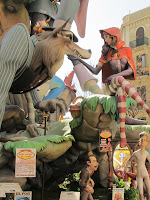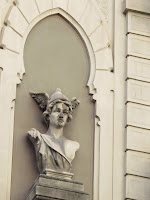Jeśli istnieje klub dla uzależnionych of regionalnych fiest, to z pewnością powinnam do niego należeć. Jeśli tylko termin, środki i inne nieciekawe elementy wypadkowe mi na to pozwalają, staram się uczestniczyć we wszystkich lokalnych imprezach uczestniczyć. W marcu padło na Walencję i słynne Fallas. Prowizorycznie hotel zablokowaliśmy już w listopadzie i mimo, że nie mogliśmy uczestniczyć w głównej atrakcji Fallas, jaką jest poniedziałkowa Crema, czyli palenie figur, to 2 dni pod znakiem petard, sztucznych ogni, tłumów i oczywiście imponujących rzeźb wystarczyły, żeby poczuć atmosferę tego jedynego w swoim rodzaju święta.




Nie wiem od czego zacząć… Od wystrzałów petard? Od pokazów fajerwerków, po których powietrze zasnute jest gęstym dymem? Od wielkich figur rodem z bajek, które jednak nawiązują bardziej do rzeczywistości niż do baśniowej fantazji? Od dominującego zapachu churros i buñuelos? Od słowniczka? A może od zarysu historycznego? Czyli skąd się wziął pomysł palenie misternie zaplanowanych i wykonanych konstrukcji? Po co przez całe miesiące buduje się niesamowite Fallas, kosztujące wcale niemało (te większe podobno ok. 100 000 euro- nie, nie dodałam żadnego 0), by potem podłożyć pod nie ogień? Tutaj na pomoc przyszła niezawodna wikipedia, według której: Początki święta w Walencji sięgają XVI wieku, kiedy to tutejsi cieśle postanowili uczcić swego patrona św. Józefa, paląc konstrukcje tworzone z drewnianych odpadów. Z czasem niektóre z nich zaczęły przybierać kształty ludzkie, by ostatecznie przekształcić się w formy znane współcześnie oraz karykatury znanych osób.


W tym roku dominowali Merkel i Sarkozy oraz chciwi bankierzy. Niektóre fallas w niezwykle obrazowy sposób przedstawiają grzechy i przywary współczesnego świata. Jednak to kryzys i marnotrawienie pieniędzy przez władze były tematem przewodnim wielu fallas. Mniejsze rzeźby, te już typowo bajkowe, bez politycznych podtekstów, wystawiają także dzieci. Bez dwóch zdań, niektóre fallas to dzieła sztuki. Aż szkoda, że pójdą z dymem.
A na ulicach prawdziwa rewia mody- piękne falleras prezentują swoje wdzięki ubrane w tradycyjne suknie, bogato obwieszone biżuterią, z włosami upiętymi w kok, podtrzymany ozdobnym i połyskliwym grzebieniem-wachlarzem.
Przy fallas ustawiane są także namioty centrum lokalnego stowarzyszenia, do którego należą fallas. Tam impreza trwa bez przerwy, gromadzą się falleras, rodziny i znajomi, by razem ugotować paellę, czy sobie podrinkować. A na ulicy bawi się całe miasto. Na każdym skwerze i parku starsi i młodsi uczestniczą w botellonie, czyli typowo hiszpański zwyczaj picia alkoholu w miejscach publicznych.
Nie zobaczyliśmy wszystkich fallas, ale przeszliśmy turystyczne dzielnice Walencji wzdłuż i wszerz. Nie uczestniczyliśmy też w imprezach towarzyszących (wyjątkiem był pokaz sztucznych ogni o 1 w nocy), ale to nie z braku chęci, ale z nadmiary chętnych. La Mascleta, czyli kilka minut odpalania petard i sztucznych ogni na plaza del Ayuntamiento zgromadziło takie tłumy, że utknęliśmy w jednej z ulic prowadzących na plac. Na ofrenda, czyli składaniu kwiatów Matce Boskiej przez falleras też nie dotarliśmy z powodu tłumów.
Ale kulinarnie tradycyjnie jedliśmy buñuelos con chocolate (pyszne pączki, w Walencji zrobione z dyni) i piliśmy horchatę. I zjedliśmy paellę na plaży.
Więcej zdjęć na stronie fcb.
I should be a star member of group for people addicted to regional fiestas. If there only existed one, which I seriously doubt (wait, should I create one?). Well, if only I can (read: it falls on weekend/ I can take days off/ I have money/ other thousand of trivial thinks I have to think of before going to one), I participate in any local fiesta. In March, it was Valencia’s time, and its big event- Las Fallas. We already booked our hotel in November and on last Friday we were ready to go and even though we missed the main event, which was Crema on Monday, I was still impressed how Spanish people love their fiestas. Impressive sculptures, firecrackers and fireworks, crowds, paella, fire, it all describes this one-of-a-kind festival.




I do not know with what to begin this post... How loud were the firecrackers? How thick and grey was the air after the firework show? About the impressive imagination of the artist that created the fallas? The figures looking as if they were taken out of fairytale, but at a second glance, reflected more e reality than a fantasy? How dominating was the smell of buñuelos and churros? Perhaps I should gove you some historical background so that the idea of burning the beautiful monuments that were planned and constructed for months? Why to make such an effort and spend so much money (some bigger fallas costed more than 100 000€, and no, I didn’t put any extra 0) and then set them on fire? Once again, thanks to Wikipedia I know that the origin of this festival In Valencia dates back to sixteenth century, when the local carpenters decided to celebrate their patron Saint Joseph by burning constructions they created with accumulated waste, especially wood, at the end of winter. With time, the constructions started taking human shape, and finally turn into a form known today , many times of caricatures of famous people.


This year, Merkel and Sarkozy, greedy bankers, crisis were the most recreated figures and themes. For a change, some other fallas represented the sins and vices of the modern world in a very graphic way. Next to big fallas, there are smaller sculptures, children’s fallas, those usually have only characters taken from fairy tales and cartoons, without political accents. Do you agree with me that some fallas are real piece of art? Shame they all go up in smoke.
It isn’t only fallas that you can admire, as there is a real beauty show on the streets. Falleras, dressed in a traditional dresses and ornate gowns, with a lot of jewels, with their hair in a bun hold with a decorative comb.
Next to the sculptures, usually there is a big tent that belongs to the local association that made the falla. There, the party never stops. Falleras, their family and friends gather to cook paella and have some drinks. And in the meantime, the whole city party on the streets. On every square and in every park older and younger participate in botellón, the typical Spanish custom of drinking alcohol in public places.
We didn’t see all the fallas, but we wanted to visit Valencia as well. We didn’t participate in all the events, but it wasn’t because we didn’t want to, it was because too many people wanted. We wanted to see a Mascleta, a few minutes long firecracker and fireworks display on Plaza del Ayuntamiento, but we got stuck on one of the streets leading to the square. We also missed ofrenda, offering of flowers to the Virgin Mary by falleras, as we were too scared by the crowds.
What we didn’t miss was the traditional food, that is buñuelos con chocolate (delicious donuts, in Valencia they wade them with pumpkin pulp) and we drank horchata. And for Sunday lunch, a paella on the beach (well, that one was a mistake)
If you want to see more photos, check the fcb page.






















































